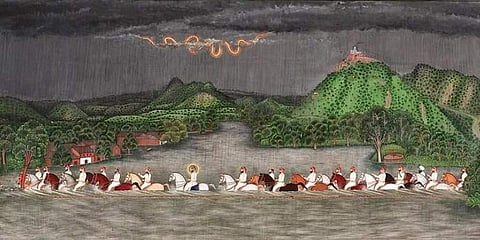
- LIFESTYLE
- FASHION
- FOOD
- ENTERTAINMENT
- EVENTS
- CULTURE
- VIDEOS
- WEB STORIES
- GALLERIES
- GADGETS
- CAR & BIKE
- SOCIETY
- TRAVEL
- NORTH EAST
- INDULGE CONNECT

It is pouring. The sky above and the river below emerging out of a submerged green valley have turned various shades of grey. The fiery orange lightning in the sky turns monstrous by the moment, as the king’s convoy of horses tries to get across the flooding river. The large-scale 19th-century watercolour painting, titled ‘Maharana Fateh Singh crossing a river during monsoon’, once exhibited in the courts of the Udaipur Palace, will now adorn the walls of the Smithsonian’s National Museum of Asian Art (NMAA) in Washington DC, beginning November 19.
A total of 63 such Indian court paintings, including several never-seen-before works, from the 17th through 19th centuries and six photographs from the 19th and 20th centuries, will be part of a new show,
A Splendid Land, which will open the centennial celebrations of the museum. As is true with all art, the show, in collaboration with the City Palace Museum in Udaipur, documents a bygone era offering viewers a window into the city’s “environmental, political and emotional” past. The works—51 on paper (roughly 3x4 feet),five works on cotton (ranging in height from five to 10 feet), and one nine-ft scroll—feature paintings of Udaipur’s palaces, lakes and mountains, in the context of the changing seasons.
“What was most exciting to me was that once we had uncovered that these paintings were about embodied experience and the large size was about being immersed, it led us to think about new possibilities to show Indian court paintings, because such works are often shown in staid ways, removed from their original context,” says Debra Diamond, the Elizabeth Moynihan Curator for South Asian and Southeast Asian Art at the NMAA.
A Splendid Land is organised as a journey that begins at Udaipur’s centre and continues outward–– first the lakes and lake palaces, then to the city, the countryside and finally to the cosmos, says Diamond,
who is a specialist in Indian court paintings.
To bring her curatorial vision to life, she has organised the paintings in a way that each room in the gallery depicts the moods of the specific locations. She says the bhaav of each work is written at the back of the painting.
“So when you come in, you are in the lakes and palaces room, and all of the paintings around you refer to that place. There is also a dominant palette of white silvery colours. When you go into the monsoon room, for example, the colours are darker and richer, evoking a whole different set of emotions,” she says.
To recreate the original immersive purpose of the works, the museum has brought in renowned experimental filmmaker Amit Dutta to create an ambient soundscape that complements the sensorial experience each room is meant to evoke.
“When you go into the lakes and palaces room, for instance, you will hear the dipping of water and the tinkling of anklets. In the monsoon room, there’s the sound of rain and peacock cries. This will allow contemporary audiences to sense—and not just see—the moods of these extraordinary places and paintings,” says Diamond.
A Splendid Land that will continue till May 14, 2023, will be accompanied by a robust programme of public events in the US, including a symposium on the ways the works reveal cultural attitudes towards natural resources and speaks to climate crises in South Asia, which will bring perspectives of the past together with insights of the future. The traditional Rajasthani band ‘Raitila Rajasthan’ will also present “music of splendid land”, featuring songs inspired from themes of Udaipur paintings on display.